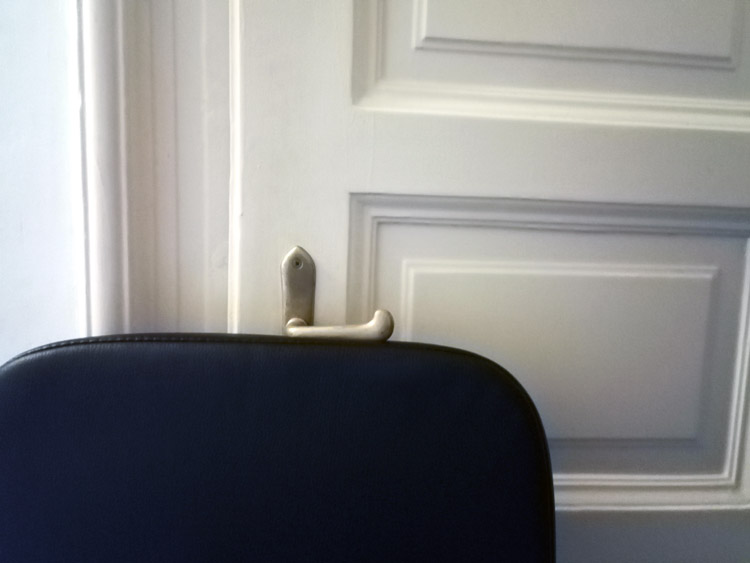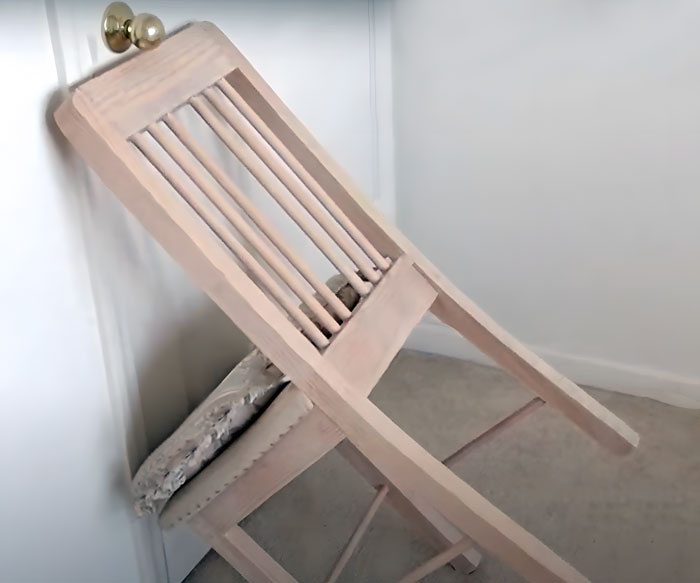Are you looking for a quick and easy way to lock a door with an average chair?
Knowing how to block a door using a chair can be a handy skill in many situations.
But there’s a catch.
You must apply the right method in the right way, otherwise, you’re doing nothing but creating a false sense of security.
Keep reading to learn the step-by-step instructions on how to lock a door with a chair in a matter of seconds.
How to Lock a Door With a Lever Handle Using a Chair
If you want to use a chair to lock a door with a lever handle, the single most important thing you should do is to prevent the latch bolt from being retracted.
This is because the latch bolt is the only thing that keeps a door without a lock closed.
A latch bolt is usually a spring-loaded unit that extends into a hole in the door frame. When you press down the lever, the bolt is pulled back and the door can be opened.
So to secure a door, all you have to do is to keep the lever in place. Here’s how you can simply and quickly do that with a chair:
Estimated time: 10-60 seconds
Steps:
- Grab a chair and place it next to the door you want to lock.
- The chair must be at least as high as the floor-to-lever distance. If the chair is lower, place books or other items under its legs so that it reaches the door handle.
- Make sure the back of the chair is facing the door.
- Place the backrest tightly under the lever in such a way that the handle cannot be pressed down.
Tip
When available, use a chair with adjustable height, such as an office chair. This makes the whole process much smoother.
Here’s a photo of a door with a lever secured with an office chair:

This way you can block both interior and exterior doors, but if your goal is to lock your bedroom door, make sure you also check out these powerful methods.
Main advantages of this method:
- If you do it right, the door handle cannot be pushed down from the outside and as a consequence, the latch bolt will keep the door closed. So it’s not the chair itself but the latch that blocks the door, which is usually a more secure solution.
- It’s a simple and quick method to improve privacy, especially if you use an office chair.
- It requires no special tools, just a chair with the right height.
- It works with both inward and outward opening doors.
Disadvantages:
- The whole method is based on the assumption that the latch bolt stays in place if you prevent the lever from pressing down. However, slanted latches often can be picked with a credit card. This is something you should keep in mind.
- It won’t withstand high forces, such as repeated kick-ins (if that is what you want to prevent, check out this guide).
- It’s a temporary solution and it’s not a substitute for a good-quality lock.
Besides using a chair, there are several other effective ways to barricade a door that you can find here.
Tip
You can significantly increase effectiveness by using the sturdiest chair available. Try to avoid using a folding chair as it’s too weak to withstand any substantial force.
How to Lock a Door With a Knob Using a Chair
If you want to use a chair to lock a door with a knob, the process is very similar to the previous method.
The main difference is that this time your goal is not to prevent the latch bolt from being retracted but to block the door itself with the chair.
Estimated time: 10 seconds
Steps:
- Find a sturdy chair that’s high enough to reach the knob.
- Place the chair in front of the door. The backrest should face the door.
- Tilt the chair slightly in such a way that the two front legs don’t touch the floor and wedge the backrest tightly under the knob.
- Check whether you can open the door.

Pros:
- It’s a quick and simple way to keep a door shut with a chair.
- No special tools are required.
Cons:
- It only works with inward-opening doors.
- It cannot withstand high forces.
- The level of security provided by this method depends on the sturdiness of the chair you use.
- The slipperiness of the floor will have a great impact on the effectiveness. You’ll get much better results with non-slip flooring (such as a carpeted floor) or with a chair with non-slip leg cups.
Putting a chair under the doorknob does work to a certain extent when done right. If you need a higher level of security, consider using a door jammer, or check out this article on the best methods to lock a door without a lock.
Tip
To make this setup more resistant to force attacks, place heavy furniture, such as a coach, right in front of the chair. This barricade will be more likely to keep an intruder outside than a single chair.
What to do if the back of the chair does not reach the knob?
If you only have a smaller chair, in most cases, you can still use that to block a door. All you need to do is turn the chair around and tilt it so the backrest is wedged under the doorknob. Now keep in mind that this setup won’t withstand as much force as the standard setup.
Here’s what it should look like:

How to Lock a Classroom Door With a Chair
If there’s an emergency, it’s extremely useful to know how you can quickly lock a classroom door using a chair. This knowledge will buy you valuable time and increase your chances of surviving an active shooting.
Estimated time: 5 seconds
Steps:
- Pick up a chair and push one of its back legs through the gap between the door handle and the door itself.
- Twist the chair in such a way that the back of it crosses the door frame.
- Check whether the classroom door is securely locked.
This method works only with levers (and not with door knobs) and with doors that open outwards (all school doors should open out).
Here’s a video demonstration:
As an alternative, you can use a door barricade anchored to the floor. Although this solution requires installation, it provides a more secure and professional way to lock a classroom door. Also, it can be used with both inward and outward swinging doors.
Frequently Asked Questions
How effective is barricading a door with a chair?
Of the three methods presented, the last one (locking a classroom door) is the most effective and reliable. In general, never rely solely on a single chair when securing a door as it will never keep a determined intruder out.
How quickly will an average chair break if force is applied?
An ordinary wooden chair without any other measure will hardly withstand a single full kick. So if someone tries to force their way into the room, a chair in itself won’t be enough. A chair with a metal frame is usually sturdier, thus it’s often a better choice.
How can I make these methods more powerful?
If the door you want to secure is without a lock, use multiple methods simultaneously. Add a portable lock, such as a security bar, u003ca href=u0022https://dailyhomesafety.com/can-a-doorstop-prevent-entry/u0022u003eplace a door stop or wedge underneath the dooru003c/au003e, or use heavy objects to reinforce the barricade.
Can you lock an outward-opening door with a chair?
An outward-opening door can only be locked with a chair if it has a lever handle and not a door knob. You can place the back of a chair firmly right under the lever in such a way that the door handle cannot be pressed down. Alternatively, if you’re dealing with a classroom door, just push one rear leg of the chair through the space behind the handle and twist the chair so that it locks the door.












